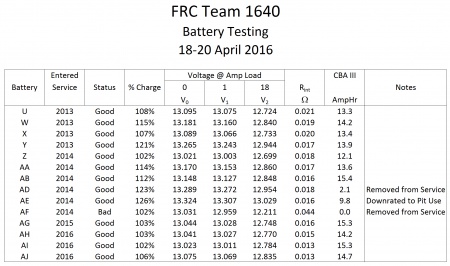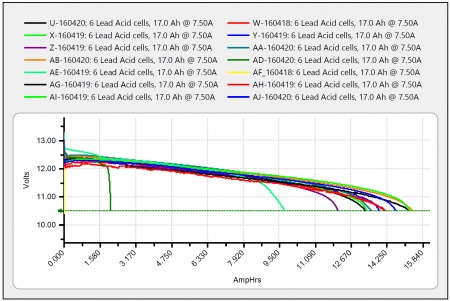Difference between revisions of "Talk:DEWBOT XII Mid-Atlantic Robotics District Championship"
MaiKangWei (talk | contribs) (→Battery Testing) |
MaiKangWei (talk | contribs) (→Proposed Battery Policy) |
||
| Line 26: | Line 26: | ||
==Proposed Battery Policy== | ==Proposed Battery Policy== | ||
| + | <big>In general</big> | ||
| + | * Batteries are identified with a 1 or 2 letter code. Batteries entering service up to the start of 2014 are lettered A-Z. Subsequent batteries enter service with 2-letter identifiers: AA-AZ; then BA-BZ; ...to ZZ. | ||
| + | * Batteries are identify the team (1640) and the tear in which they entered service. | ||
| + | * Competition-rated batteries are indicated by a blue sticker. | ||
| + | * Non-competition batteries are indicated by a yellow sticker. | ||
| + | * Failed batteries are indicated by a red sticker and leads are removed. | ||
| + | * Failed batteries are recycled at the earliest convenient time. | ||
| + | * Batteries are Competition rated if: | ||
| + | :# They have been CBA tested and delivered >11.0 AmpHr during their latest CBA test; and | ||
| + | :# They rate "Good" by Battery Beak and >100% charge after being fully recharged; and | ||
| + | :# Have not been identified during an ongoing competition as a "problem-battery"; and | ||
| + | :# Have not been dropped since the last CBA test; and | ||
| + | :# Have no visible signs of damage to the battery case, relief valve, cables or connectors. | ||
| + | * Batteries are non-competition (yellow sticker) rated if: | ||
| + | |||
| + | <big>At competition</big> | ||
| + | * | ||
| + | |||
| + | <big>CBA Testing</big> | ||
| + | *CBA testing of ALL competition | ||
---- | ---- | ||
[[Category:DEWBOT XII]] | [[Category:DEWBOT XII]] | ||
Revision as of 15:10, 24 April 2016
Post-Mortem
Battery Testing
In spite of the fact that we test all batteries with a Battery Beak (Manufactured by Cross the Road Electronics - marketed by AndyMark) before competition, we experienced two battery failure in competition: one at Westtown (battery AD) and a more complete one at MAR Championship (battery AF) where we just managed to crawl to the batter at the start of the match.
As a result, we tested all competition-rated batteries 18-20 April using the CBA (Computerized Battery Analyzer) III (manufactured by Optim Engineering - marketed and sold by West Mountain Radio). The CBA measures the voltage of a battery over time under a fixed current load until a set terminal voltage is reached. For this testing, the load is set to 7.5 amps; terminal voltage to 10.5 volts. The CBA reports Amp Hrs.
The data collected on the batteries is here (right):And the CBA III performance charts (below):
Three batteries were removed from service as a result of the testing: AD, AE & AF. Note that AC had previously been removed from service. The batteries AC-AF all entered service in 2014 and came from two consecutive orders of two batteries each. With the exception of these four batteries, the only other gap in our in-service batteries is "V" from 2013. "U" is the oldest battery in service (also from 2013), so "V" almost certainly died of old age. This makes the AC-AF group appear as if it may be associated with a manufacturing QC lapse.
Read the full CBA III Report.
Our last full battery test with the CBA III was conducted in March 2014. These test are labor and time intensive. Since then, we have relied on the Battery Beak to assess battery health.
Key findings of this test are:
- The Battery Beak does not identify all failed batteries. As a result, reliance on the Battery Beak alone exposes the team to battery failures in competition (as at Westtown & MAR Championships).
- The CBA III does appear to correctly identify failed batteries (as identified by competition failures) which the Battery Beak misses.
- The CBA III appears to also identify failing batteries (such as "AE"), allowing these to be removed from competition service prior to obvious failure.
- It is clear that the team should reinstitute a regular CBA testing regime.
The CBA III is no longer manufactured. The team has ordered a CBA IV from West Mountain Radio. This augments rather than replaces the old CBA III (with is compatible with Windows 10). The team has also ordered two replacement batteries to be delivered to our pit at FRC Championship.
Proposed Battery Policy
In general
- Batteries are identified with a 1 or 2 letter code. Batteries entering service up to the start of 2014 are lettered A-Z. Subsequent batteries enter service with 2-letter identifiers: AA-AZ; then BA-BZ; ...to ZZ.
- Batteries are identify the team (1640) and the tear in which they entered service.
- Competition-rated batteries are indicated by a blue sticker.
- Non-competition batteries are indicated by a yellow sticker.
- Failed batteries are indicated by a red sticker and leads are removed.
- Failed batteries are recycled at the earliest convenient time.
- Batteries are Competition rated if:
- They have been CBA tested and delivered >11.0 AmpHr during their latest CBA test; and
- They rate "Good" by Battery Beak and >100% charge after being fully recharged; and
- Have not been identified during an ongoing competition as a "problem-battery"; and
- Have not been dropped since the last CBA test; and
- Have no visible signs of damage to the battery case, relief valve, cables or connectors.
- Batteries are non-competition (yellow sticker) rated if:
At competition
CBA Testing
- CBA testing of ALL competition

